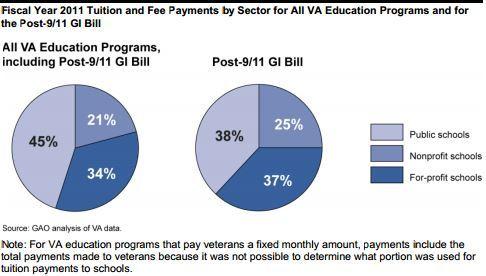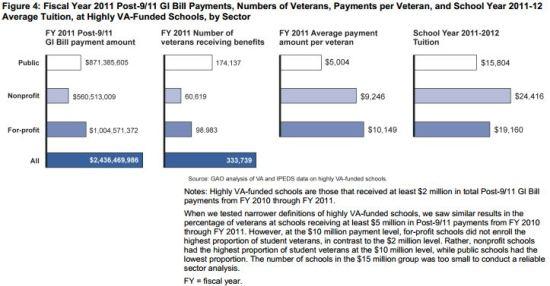The Basics
- Passed in 2008 and administered by the U.S. Department of Veterans Affairs (VA);
- All service members on active duty for 90 days or more since 9/10/2001 and who were discharged honorably are eligible;
- In 2011-12, the VA disbursed nearly $8.5 billion to roughly 646,300 veterans in Post-9/11 GI Bill funds;
- In that year, nearly $11 billion in educational support was distributed to nearly 1 million veterans overall;
- The GI Bill money granted to student veterans does not count in calculating whether a school complies with the “90/10” rule, which prohibits institutions from deriving more than 90 percent of their revenue from federal student aid—a policy aimed mainly at for-profit colleges.
Where Do Veterans Enroll?
In July 2013, the Government Accountability Office released a comprehensive report of student veteran activity.
Among the findings:
The report noted that roughly 5 percent of U.S. colleges and universities received 60 percent of all Post-9/11 GI Bill tuition benefit dollars.
The GAO reviewed schools that receive a large amount of GI Bill funds. Below is a chart characterizing all institutions that took in at least $2 million in GI Bill payments. Within this group of schools, for-profit institutions took in the most dollars, and their students received the highest average benefits amount.
Who Gets What
- The GI Bill benefits structure is tiered based on duration of service:
- The maximum benefit is determined by the type of institute of higher learning (IHE) attended:
- Tuition support for certain vocational or correspondence schools is lower, with a maximum award range of $9,300 to just under $11,000.
- A $1,000 book and supplies stipend is included for each academic year.
- The GI Bill does not preclude use of other federal postsecondary loans and grants, such as the Stafford Loan and the Pell Grant.
Housing Allowance
- A housing allowance is provided for students enrolled for more than half the school year. It is based on a formula the Department of Veterans Affairs uses that factors in the location of the institution and whether the student veteran has dependents. For example, here is the monthly housing allowance provided for a student enrolled at a school in Washington, D.C. (In the example below, E-5 is the service member pay grade that’s used to calculate a student’s housing stipend.)
Additional Funding for Student Veterans: Yellow Ribbon Program
- Colleges or other educational institutions that partner with the federal government can provide additional financial assistance to a student and have that amount matched by the VA.
- Private schools with tuition that exceeds the amount awarded through the GI Bill are eligible, as are public schools with housing costs that exceed the benefits package of the GI Bill.
- The VA publishes a list of all eligible institutions and notes the cap on how much money is matched and how many students can be enrolled under the Yellow Ribbon Program per year within each institution.
- For example, at Stanford University’s law school, there’s no cap on the additional assistance or number of students who are eligible. Other programs limit the number of students from four to 200, for example, and cap the money the school will provide from $2,000 to $20,000 or more in some cases.
Use It or Lose it
- The Post 9/11 GI Bill can be used for 36 months of schooling. The typical full academic year in a postsecondary setting lasts nine months. The GI Bill therefore essentially provides funding for four academic years.
- A veteran has 15 years from the date he or she served before eligibility for the GI Bill expires. The Montgomery GI Bill (the World War II version) had a use-it-or-lose-it window of 10 years.
- Veterans can transfer their Post-9/11 GI Bill benefits to spouses and children under certain conditions.
Transcript Woes
- Many veterans complete their armed forces tours having acquired certain skills that are not easily transferrable to institutions of higher learning. For example, a medic from the Navy may have acquired the skills needed to satisfy the bulk of her entry-level science courses, but still be forced to take those courses at her college or university. This disparity can lead to veteran students spending more time in school than is necessary, an oftentimes costly proposition that may reduce the likelihood of degree completion.
- The American Council of Education provides a transcript student veterans can show to schools that translates their skills into the types of courses typically offered at a college or university (sample transcript).
- Recently, colleges and universities have argued that ACE could disclose more information about how it evaluates training and programs within the armed forces so that schools can more accurately reward incoming students with course credits.
- Not all schools have a service coordinator who can provide information to incoming veterans that would help them avoid taking classes that they do not need, like having the right transcript paperwork.
U.S. Department of Education’s ‘8 Keys to Success’
- This is a new initiative from the U.S. Department of Education.
- Postsecondary institutions agree to follow and generate best practices on a host of issues that affect student veterans, from social, financial and academic support on campus to partnerships with local businesses that improve a student veteran’s chance of finding employment.
- Hundreds of universities, mostly community colleges and some state schools, have partnered with the Education Department; many schools have applied to join the initiative.
- To date, no for-profit institutions have officially partnered with the Education Department.
- The 8 Keys initiative is nonbinding and the Education Department has no formal enforcement mechanism to hold schools to their promises.
- Learn more about the Education Department’s efforts here.




